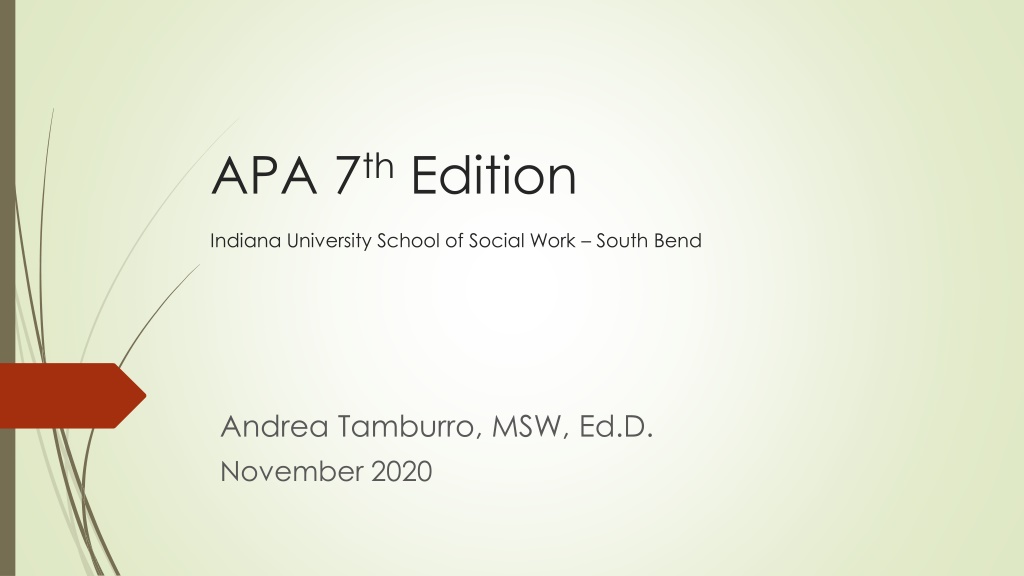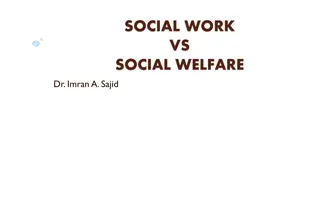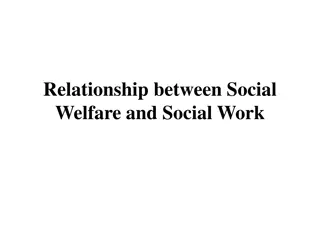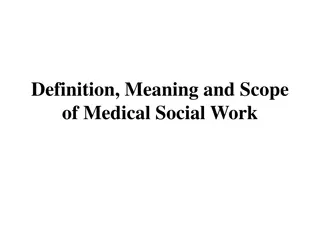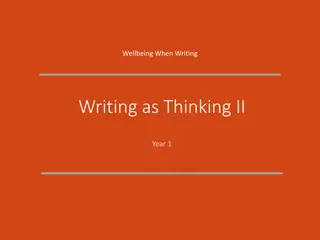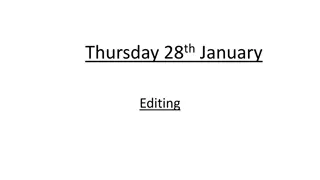Effective Writing Strategies for Social Work Professionals
Learn essential guidelines for scholarly and professional writing, including accurate punctuation, spelling, grammar usage, critical analysis, evidence-based arguments, and avoiding plagiarism. Understand the types of reports social workers write, importance of proofreading and editing, and the consequences of plagiarism according to the NASW Code of Ethics.
Download Presentation

Please find below an Image/Link to download the presentation.
The content on the website is provided AS IS for your information and personal use only. It may not be sold, licensed, or shared on other websites without obtaining consent from the author. Download presentation by click this link. If you encounter any issues during the download, it is possible that the publisher has removed the file from their server.
E N D
Presentation Transcript
APA 7thEdition Indiana University School of Social Work South Bend Andrea Tamburro, MSW, Ed.D. November 2020
Scholarly and Professional Writing Provide a clear explanation Use accurate punctuation Spell accurately use spell check in Word Use correct grammar use grammar check in Word Analyze critically Support your arguments with evidence Make sure your data is accurate Give credit to avoid plagiarism
National Association of Social Workers Code of Ethics Code of Ethics identify several types of reports that are written by social workers: Reports to courts and police in the case of abuse, neglect, risk of self-harm, or harm to others. Case records, which can be examined by clients and subpoenaed by courts. Reports and records must be written clearly, accurately. Descriptions must be complete. (NASW Code of Ethics, 2017. http://www.naswdc.org/)
Steps: Write, Then Proofread, Then Edit 1. 2. 3. Review the instructions Research, research, research academic peer-reviewed resources Start writing your assignment several days ahead of the due date. Write a draft. Let it sit, get an editor, read aloud. Check the content review the instructions. Look for gaps! Proofread Make sure the sentences are clear and complete. Do your sentences and paragraphs support or disconfirm the arguments made in your research? [include both confirming and disconfirming evidence] Will a reader understand your arguments? Look for information that will fill the gaps and find support for information that needs confirmation. 10. Final Edit look for typos, grammatical errors. When we revise sentences, sometimes words from the original sentence remain. 4. 5. 6. 7. 8. 9.
Plagiarism Policy IUSSW Plagiarism is a form of cheating and is grounds for failing the course and possible dismissal from the program and/or university. Plagiarism is defined as presenting someone else s work, including the work of other students, as one s own. Any ideas or materials taken from another source for either written or oral use must be fully acknowledged, unless the information is common knowledge. What is considered common knowledge may differ from course to course.
More of the Plagiarism Policy IUSSW A student must not adopt or reproduce ideas, opinions, theories, formulas, graphics, or pictures of another person without acknowledgment. A student must give credit to the originality of others and acknowledge indebtedness whenever: 1. Directly quoting another person s actual words, whether oral or written; 2. Using another person s ideas, opinions, or theories; 3. Paraphrasing the words, ideas, opinions, or theories of others, whether oral or written; 4. Borrowing facts, statistics, or illustrative material; or 5. Offering materials assembled or collected by others in the form of projects or collections without acknowledgment. 6. Self-plagiarism: A student must not submit substantial portions of the same academic work for credit or honors more than once without the permission of the instructor or program to whom the work is being submitted.
You need to know it, but do not need to buy it Here is a link to some of the changes. https://apastyle.apa.org/
Starting with the Basics APA Template Formatting Order of pages Title Page Font Header Line Spacing Margins Paragraph Alignment and Indentation Headings Sample Papers Accessibility https://apastyle.apa.org/style-grammar-guidelines/paper-format
Use Only a Few Quotes You are conveying your ideas and supporting them with data from other sources. Use your writing voice. Explain how the quote relates to your topic. Quote . . . when reproducing an exact definition (see Section 6.22 of the Publication Manual), when an author has said something memorable or succinctly, or when you want to respond to exact wording, such as something someone said. This information is quoted from the following site: https://apastyle.apa.org/
Effective Paraphrasing Avoid Plagiarism 1. Read and reread the original section of the document to understand the information. 2. Cover the original document and write your summary. 3. Above your summary, write key words or a phrase to identify the topics. 4. Make notes, including citation, with the paraphrase reminding yourself how you plan to use this information. [Perhaps use brackets.] 5. (Purdue OWL, 2007)
Effective Paraphrasing 5. Next compare your summary to the original to ensure your version reflects accurately the essential ideas and information. 6. Italics (not quotation marks)can be used highlight unique terms or phrases that you have used from the original source. 7. Note the source, including the page number, next to your summary so you can cite the information. (Purdue OWL, 2007)
Quoting and Paraphrasing Quote: Karger and Stoesz (2010) indicated that, [p]overty is a fluid . . . process for most Americans. The University of Michigan s Panel Study of Income Dynamics . . . followed 5,000 families for almost 10 years (1969 1978) and found that 2 percent of families were persistently poor throughout the entire period (p. 112). Example paraphrase: Karger and Stoesz (2010) cited a University of Michigan study which indicated that most families in the 1970s were only poor temporarily.
Paraphrase this Block Quote A number of authors indicated that, [a]lthough beginning practitioners often think that methods, approaches, or skills are the critical factors in achieving good client outcomes, clients surveyed in many research studies reported that the relationship qualities of warmth, respect, genuineness, empathy, and acceptance were most important (Beutler, Machado, & Allstetter-Neufelt, 1994; Flaskas, 2004; Krupnick et al., 1996; Metcalf, Thomas, Duncan, Miller, & Hubble, 1996; Smith et al., 2004). (Chang, et al., 2009, p. 49) Comment: Note, Chang, Scott, and Decker are the authors of the quote.
Citations In-Text: Parenthetical (in parentheses)citation integrated in the sentence References listed at the end
Reasons Why In-Text Citations Are Needed Help reader find the information Identify authors who provided evidence to support your ideas. Support your statements if several authors made similar statement, it lends credibility. Provide credit Acknowledge the intellectual property of others Avoid plagiarism
When to Cite Cite quotations and paraphrased information Cite sources to document all facts and figures that you mention that are not common knowledge. Cite information you have read and ideas you have incorporated Include only citations needed to support your immediate point. Cite primary sources when possible and cite secondary sources only when necessary. To cite a specific part of a source, provide an author date citation for the work plus information about the specific part. Cite personal communications in the text of the paragraph (According to Dr. Johnson, the Director of Health Services, at Apex Health Care . . . Comment: The above information is quoted from the following site: https://apastyle.apa.org/
In-Text Citations Each in-text citation must correspond to only one reference list entry. Do not include suffixes such as Jr. in the in-text citation. For works with an unknown author (see Section 9.12), include the title and year of publication in the in-text citation. In parenthetical citations, the author s last name and publication date appear in parentheses. In narrative citations, the author s last name is incorporated into the text as part of the sentence and the year follows in parentheses. When multiple references have an identical author (or authors) and publication year, include a lowercase letter after the year. If the first authors of multiple references share the same surname but have different initials, include the first author s initials in all in-text citations, even if the year of publication differs.
More about In Text Citations Type of Author Narrative citation, used when citing one or two sources. Parenthetical citation, used when listing sources. One author (Thigpen, 2019) According to Thigpen (2019) . A comparison of a study by Walker (2019) and a study by Thomas (2016) . Lucas and Johnson (2018) found that . T. Smith and F. G. Smith (2020) examined In a study by McDonald et al., (2018), they found National Association of Social Workers (NASW), 2020 (Walker, 2019; Thomas, 2016) Two authors (Lucas & Johnson, 2018) (T. Smith & F. G. Smith, 2020) Three or more authors same in all citations Group author including abbreviation in first citation (McDonald et al., 2018) (National Association of Social Workers [NASW], 2020) Second citation NASW, 2020 (NASW, 2020) Group author with no abbreviation Indiana University, 2020 (Indiana University, 2020) Based on information from the following site: https://apastyle.apa.org/
In-Text Citations Example 1 Example below: To provide effective services, social work students need to be better prepared to work with Indigenous peoples, families, and communities (Weaver, 1997b, 2005). Explanation: The date 1997b was used because the author of the paragraph has cited two articles by Weaver written in 1997. The first article cited is listed 1997a and the second article cited is listed as 1997b in the in-text citation and in the references.
In Text Citations Example 2 Research has demonstrated that writing is an essential skill that undergraduate students in social work need to develop (Alter & Adkins, 2001, 2006; Horton & Diaz, 2011; Waller, 2000). Explanation: notice the authors are in alphabetical order, not ordered by date.
Examples 3 of In Text Citations Baskin (2005b) stated that [t]here is much anecdotal evidence from Aboriginal helpers on how current social work education does not represent them, their world views [sic] or the situations in their communities (p. 2). Explanation: [sic] is a Latin word used in older texts. It indicates a style or error. It means the person writing the quote thinks the reader of the quote could think it was misquoted.
Citing Multiple Authors and Sources Twenty years after a study by Shaughnessy and Brown (1979), Weaver (1999) conducted a similar study. Weaver surveyed 62 U.S. social workers and social work students who were Native American. Weaver identified the knowledge, skills, and values [were found to be] necessary for culturally competent service provision to Native American clients (p. 218). Explanation: Note the words were found to be were inserted into the quote. Brackets indicate your insertion.
In Text Citations for Quotations Add Page Numberss According to Tamburro and Harris (2016), [d]ecades of research demonstrates that many social work undergraduate students need to develop more effective writing skills (Alter & Adkins, 2001, 2006; Horton & Diaz, 2011; Waller, 2000) (p. 51). Decades of research demonstrates that many social work undergraduate students need to develop more effective writing skills (Alter & Adkins, 2001, 2006; Horton & Diaz, 2011; Waller, 2000) (Tamburro & Harris, 2016, p. 51).
In-Text Citations for Quotations if There Are No Page Numbers Webpages, include the heading or section name, paragraph number, combine section name and paragraph number (https://apastyle.apa.org/). Example: People planning for retirement need more than just money they also need to stockpile their emotional reserves to ensure adequate support from family and friends (Chamberlin, 2014, para. 1) (https://apastyle.apa.org/). If there is no page number, include canonically numbered sections. Example: The National Association of Social Workers Code of Ethics Section 2 explains social worker s ethical responsibilities to colleagues. 2.01 Respect states (a) Social workers should treat colleagues with respect and should represent accurately and fairly the qualifications, views, and obligations of colleagues.
In-Text Citations with 3 or More Authors The first citation and subsequent citations of three more authors now includes the first (primary author) and et al. Et al. is a Latin abbreviation for et alia, which means and others . Repeating a citation Include the author(s) and year for every parenthetical in- text citation. Do not repeat the year for narrative in text citations the second and subsequent times they appear in a single paragraph. Follow this guideline with each new paragraph (i.e., include the year in the first narrative citation in a new paragraph). https://apastyle.apa.org/style-grammar-guidelines/citations/basic-principles/author- date#parenthetical-narrative
In-Text Citation for the First Citation and Subsequent Citations of three more authors Example: Chang et al. (2019), provide some guidance about asking questions. They suggest that leading questions are a subtle form of giving advice and should be avoided, at least until the client has established concrete goals (Baxter et al., 2013). Also, clients may feel interrogated if the practitioner asks questions without exploring the meaning of the answers (Chang et al.). In addition, Chang et al. indicated that asking more than one question at the same the same time can be confusing.
In-Text Citations Repeating a Citation Cite multiple works by using the same author or authors, regardless of the publication years, include the date in every in-text citation to prevent ambiguity. Explanation: Gonzales and Brown (2017) and Gonzales and Brown (2019), include the year with every citation, even when one of the references is cited multiple times in a single paragraph. Example: Although advice is often given in ordinary conversations, according to Chang et al. (2014) and Chang et al. (2019), it is not helpful social workers to offer advice. They suggest helping clients sort out their own decisions, because giving advice can reinforce the practitioner s power and authority. Also, offering excuses and reassuring is generally inappropriate(Chang et al., 2009; Chang et al., 2019).
Quotations For quotations of fewer than 40 words [not including the citation], add quotation marks around the words and incorporate the quote into your own text there is no additional formatting needed. Example: Effective teams can be difficult to describe because high performance along one domain does not translate to high performance along another (Ervin et al., 2018, p. 470). Place a parenthetical citation either immediately after the quotation or at the end of the sentence.
Paraphrased Quotation For a narrative citation, include the author and year in the sentence and then place the page number or other location information in parentheses after the quotation. Example: According to Ervin et al. (2018), effective teams can be difficult to describe because high performance along one domain does not translate to high performance along another (p. 470).
Quoting a quote in a Secondary Source A survey of social workers reveals tremendous diversity in perspectives guiding social work practice (Norlin and Chess (1997), as cited in Miley et al., 2011, p. 25). Explanation: Miley et al. (2011) quoted Norlin and Chess and you quoted Miley et al. Note the page number for the Norlin & Chess is not provided. Reference Miley, O Meila, and Dubois in the references at the end.
Block Quotes 40 or more words Do not use quotation marks to enclose a block quotation. Start on a new line and indent the whole block 0.5 in. from the left margin. Double-space the entire block quotation. Do not add extra space before or after it. If there are additional paragraphs within the quotation, indent the first line of each subsequent paragraph an additional 0.5 in. (a) cite the source in parentheses after the quotation s final punctuation or (b) cite the author and year in the narrative before the quotation and place only the page number in parentheses after the quotation s final punctuation. Do not add a period after the closing parenthesis in either case. https://apastyle.apa.org/style-grammar-guidelines/citations/quotations#with-page- numbers
Block Quote Instructions Quotations of 40 or more words To count the words of a quote, copy and paste it into Word. (Microsoft Word shows word count at the bottom left of the screen.) Double Space. Place a period at the end of the quote not at the end of the citation. For a quotation inside the block quote, use double quotation marks. Indent using the Home Paragraph Tab
Block Quote Exercise A number of authors indicate that, [a]lthough beginning practitioners often think that methods, approaches, or skills are the critical factors in achieving good client outcomes, clients surveyed in many research studies reported that the relationship qualities of warmth, respect, genuineness, empathy, and acceptance were most important (Beutler, Machado, & Allstetter-Neufelt, 1994; Flaskas, 2004; Krupnick et al., 1996; Metcalf, Thomas, Duncan, Miller, & Hubble, 1996; Smith et al., 2004). (Chang, et al., 2009, p. 49)
Exercises Block Quote Open Microsoft Word Practice formatting a block quote from the previous slide.
Web Citation Example 1 APA in-text web citation style uses the author's last name and the year of publication, for example: (Field, 2005). For direct quotations, include the page number as well, for example: (Field, 2005, p. 14). For sources such as websites and e-books that have no page numbers, use a paragraph number.
Web Citation Example 2 In text citation of a webpage that you have paraphrased (written in your own words): The National Association of Social Workers suggested that it was necessary for social workers to take care of themselves (https://www.socialworkers.org/assets/secured/documents/s ections/atod/newsletters/2017%20ATOD%20Spring%20- %20Summer%20Issue.pdf).
Web Citation Parenthetical Format In text citation of a webpage that you have paraphrased (written in your own words): Social workers writing demonstrates their professionalism (National Association of Social Workers, 2011). Reference: National Association of Social Workers (2011) Strengthening your writing skills: An essential task for every social worker. https://careers.socialworkers.org/documents/WritingSkillsLL.pdf
Web Citation Narrative Format The National Association of Social Workers (NASW) provides tips for professional writing in their webpage, Strengthening your writing skills: An essential task for every social worker (2011). They suggest that a social worker s writing demonstrates her or his professionalism to others.
Web Citations Quotes The National Association of Social Workers (NASW) cautions professionals to [b]e aware that everything you write reflects on you as a professional (NASW, 2011, para. 16).
Webpage with Authors Name Example: Ferrer (n.d.) identified the major role that social workers have played in advancing the rights of people and reforms to change policies which oppressed people. These changes include health care, laws protecting children, equality with regard to gender, sexual orientation, race, and ethnicity. Reference: Ferrer, D. (n.d.). 23 defining moments that every social worker should know . https://thebestschools.org/magazine/23-defining- moments-of-social-work/.
In Text Citation - Quote Effective writing enables you to communicate your message succinctly and persuasively (NASW, 2011, para. 3)
Web Citation Quote The NASW, 2011 webpage Strengthening your writing skills, suggests that as social workers, you must [m]ake a practice of reviewing your own work for errors in spelling, grammar, and style. One effective technique is to read your work aloud (para. 7).
Always include sources cited within the document in references at the end. List at the end with dates first in chronological order, then in alphabetical order. The reference page is called: References
References You no longer need to include the location of the publisher. Surnames and initials for up to 20 authors (instead of 7) should be provided in the reference list. Digital Object Identifiers are formatted the same as URLs. Omit DOI label. New DOI Format: https://doi.org/10.1080/02626667.2018.1560449
Reference List Author: Who is responsible for this work? Date: When was this work published? Title: What is this work called? Source: Where can I retrieve this work?
References - Book Author(s) (Publication Date). Title of the publication. Name of the Press. Example: Young, D. (2014). The writer s handbook: A guide for social workers. Writer s Toolkit Publishing LLC. Example of a book chapter: Tamburro, A. (2014). Literature Review. In D. Young (Ed.), The writer s handbook: A guide for social workers. (pp. 51-76). Writer s Toolkit Publishing LLC.
References - Journals Author(s) (Publication Date). Title of the article. Title of the Publication, Volume # (Issue #), page #s. doi. (older articles may not have a doi) Examples: Falk, D. S., & Ross, P. G. (2001). Teaching social work writing. The Journal of Baccalaureate Social Work, 6(2), 125-142. Graham, S., & R. Harris, K. (2000). The role of self- regulation and transcription skills: In writing and writing development. Educational Psychologist, 35(1), 3-12. https://doi.org/10.1080/02626667.2018.1560449
Journal Reference: Include DOI but Not Title Macdonald, R., & Carroll, J. (2006). Plagiarism a complex issue requiring a holistic institutional approach. Assessment & Evaluation in Higher Education, 31, 233 245. 10.1080/02602930500262536 Johnstone, K. M., Ashbaugh, H., & Warfield, T. D. (2002). Effects of repeated practice and contextual-writing experiences on college students writing skills. Journal of Educational Psychology, 94, 305 315. 10.1037/0022-0663.94.2.305
References - Website National Association of Social Workers. (2011). Strengthening your writing skills: An essential task for every social worker. Retrieved from http://careers. socialworkers.org/documents/WritingSkillsLL.pdf American Psychological Association. (2011). Learning APA Style. Retrieved from http://www.apastyle.org/ learn/index.aspx Check your links to make sure they work before turning in the assignment.
